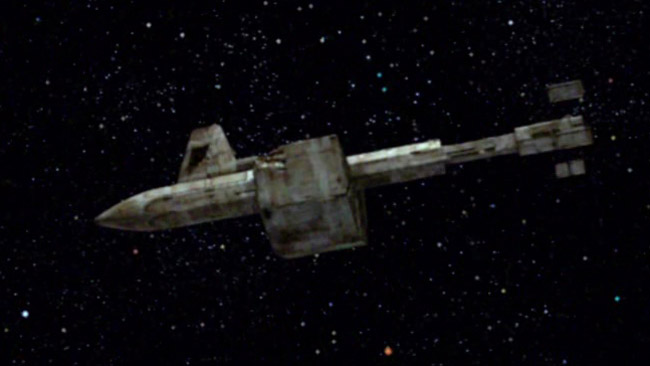Difference between revisions of "DY-100 class (FASA)"
m |
m |
||
| Line 4: | Line 4: | ||
{{TableRow|title=Advertising|data={{AmazonLink2}}}} | {{TableRow|title=Advertising|data={{AmazonLink2}}}} | ||
|}</div> | |}</div> | ||
| − | The DY-100, introduced in [[FASA Timeline: 1990s#1995|1995]], was the first mass-produced spacecraft capable of routine circumlunar ([[Earth]]-[[Moon (Sol IIIa)|moon]]) travel. Interchangeable modules permitted wide diversity of mission profiles, including an upgrade for interplanetary travel that allowed it to take humans to [[Mars | + | The DY-100, introduced in [[FASA Timeline: 1990s#1995|1995]], was the first mass-produced spacecraft capable of routine circumlunar ([[Earth (FASA)|Earth]]-[[Moon (Sol IIIa)|moon]]) travel. Interchangeable modules permitted wide diversity of mission profiles, including an upgrade for interplanetary travel that allowed it to take humans to [[Mars (FASA)|Mars]].<ref name="SFC"/> The class featured [[cryogenics|cryogenic]] systems due to the long travel times involved in early spaceflight,<ref name="TOS24"/> and remained in service until [[FASA Chronology: 2020s#2020|2020]].<ref name="SFC"/> |
{{InfoBox|float=left;|name=Specifications<ref name="SFC"/>}} | {{InfoBox|float=left;|name=Specifications<ref name="SFC"/>}} | ||
{{TableRow|title=Length|data=100 [[meter|m]]}} | {{TableRow|title=Length|data=100 [[meter|m]]}} | ||
| Line 29: | Line 29: | ||
{{References}} | {{References}} | ||
<references> | <references> | ||
| + | <ref name="TOS24">{{RefTOS24}}</ref> | ||
<ref name="SFC">{{RefSFC}}</ref> | <ref name="SFC">{{RefSFC}}</ref> | ||
</references> | </references> | ||
Revision as of 17:23, 10 October 2020
The DY-100, introduced in 1995, was the first mass-produced spacecraft capable of routine circumlunar (Earth-moon) travel. Interchangeable modules permitted wide diversity of mission profiles, including an upgrade for interplanetary travel that allowed it to take humans to Mars.[1] The class featured cryogenic systems due to the long travel times involved in early spaceflight,[2] and remained in service until 2020.[1]
| Length | 100 m |
| Beam | 23.37 m |
| Draught | 34.9 m |
| Mass | 2.72 million kg |
| Living/Fuel/Cargo Units | Interchangeable modules each 27x5.5x6.57m (795m³ usable volume) |
| Engine Section | Combination Chemical/Fission • Diameter: 6.13 m • Length: 19m |
| Command Con | 12.3x7.4x4.9 m |
| Complement | • Officers: 2 • Crew/Passengers: 0-20 |
| Navigation | Optical Tracker-Controlled Inertial Guidance |
| Communications | Laser Radiotelemetry |
| Computer | Standard Program-Dependent Digital Memory |
| Life Support | • Gravity: No internal control • Atmosphere: 34.7% O2; 11% humidity |
| Range | • Standard: 900,000 km • Maximum: 387 million km (refit for duration travel) |
| Velocity | • Cruising: 55,000 km/hour • Maximum: 80,000 km/hour • Escape Velocity (Earth): 38,000 km/hour |
| Voyage Duration | • Typical (Earth-Moon): 9.2 hours • Maximum (Earth-Mars-Asteropolis-Mars-Earth): 934 days (with supply stops) |
| Thrust | • Chemical: Six chemical boost engines for Earth escape producing 4.2 million kg • Fission: One Amjet hydrogen fission thruster for interplanetary transfer producing 68,000 kg (average) |
DY-100 class vessels
Prime Timeline
Columbia Timeline
LUG Timeline
S.S. Botany Bay DY-109 • S.S. Iberville DY-120 • S.S. Lyons Creek DY-166 • S.S. Monticello DY-158 • S.S. Salisbury DY-131 • S.S. San Juan DY-177 • S.S. Santa Maria DY-164 • S.S. Shenandoah DY-178 • S.S. Wacosta DY-104
FASA Timeline
S.S. Botany Bay • S.S. Copernicus
Kelvin Timeline
Myriad Universes
Notes and References
- ↑ 1.0 1.1 1.2 1.3 Goldstein, Stan et al (Authors). Spaceflight Chronology. Star Trek. Book. Wallaby Books. 1980.
- ↑ Roddenberry, Gene (Executive Producer). "Space Seed." Star Trek, Season 1, Episode 22 (Production 24). Directed by Marc Daniels. Written by Carey Wilber (Story and Teleplay) and Gene L. Coon (Teleplay). Desilu Productions, 16 February 1967.

